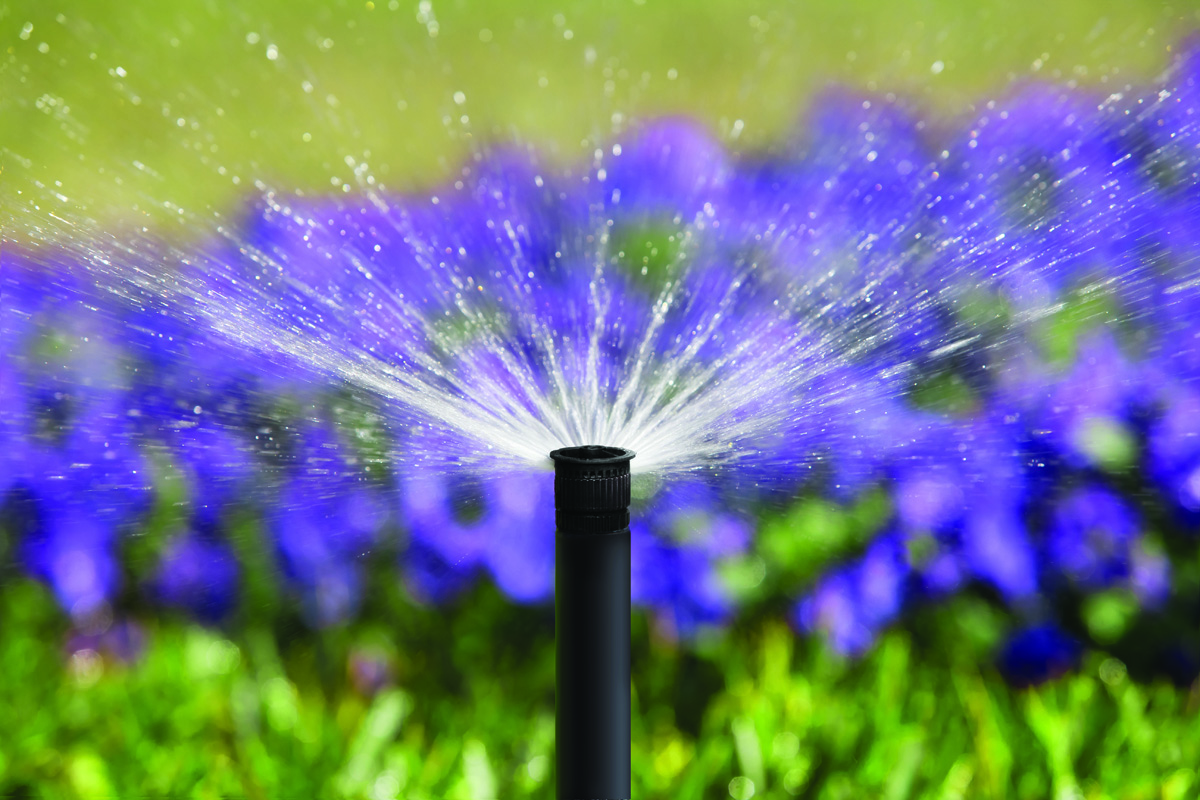The conversation in many places around the country often turns to water. The first question most contractors are asking in Northern California is: “Is it feasible to maintain healthy turf with a 25 percent cutback in water usage looming on June 1?” The answer is yes: There are a ton of available water-efficient technologies—but before you get too far down the path of options, there are a few things to accomplish.
Maintain proper pressure.
Maintaining proper system pressure is the key to any irrigation solution working successfully. In the Redding, Calif., area, for example, pressure can top 125 PSI. If the irrigation system works at all, it will certainly atomize the water at the nozzle, converting water into very fine particles that can lead to pattern irregularities, misting, evaporation and drift. There are many options to help regulate pressure in an irrigation system, such as Hunter’s Accu-Sync, Pro-Spray PRS, Rain Bird 1800 PRS, or PRS Dial.
 Give the system a good tune-up.
Give the system a good tune-up.
First, ensure your system is operating at proper pressure. Then, check for leaks, adjust heads for overspray, replace worn riser seals, check for runoff, and correct nozzle size. Use Ewing’s free Water Smart Site Checklist form for an easy inspection checklist.
In our area, most homes are built atop hardpan, with an overlay of just 6 inches of topsoil. If there is a leak or over watering occurs, water may percolate through the topsoil, but not penetrate through hardpan surface; thus runoff can occur easily. Check for runoff downhill, even at the neighbors’. If runoff is a problem, swap out spray nozzles and impacts with multi-stream multi-trajectory rotary nozzles (Hunter’s MP Rotators or Rain Bird’s R-VAN) or gear drives (Hunter’s PGP or Rain Bird’s 3500 series).
These solutions will offer a greater distribution uniformity for more even coverage, but also apply water at a slower rate, allowing for greater absorption into the soil profile.
Worn riser seals and low head drainage may also cause water to run across sidewalks or down the street. To eliminate this problem, replace caps, bodies and/or add check valves as warranted.
Pay attention to the controller
Once your system is effectively tuned up and any pressure problems have been resolved, attention should be paid to the controller. Most manufacturers have a seasonal adjustment controller setting, which will enable it to make small adjustments as the weather changes throughout the year. In the summer, more water may be required, and in the fall, a seasonal adjustment can reduce the durations of waterings. For example, if your run times are set for one hour in the summer, and you adjust the seasonal adjustment to 50 percent as the weather changes, your run times will now be 30 minutes.
To take this to the next level, use an EPA WaterSense certified controller, like Hunter's X-Core and Solar Sync. When set properly, these options will automate the seasonal adjustment with the added benefit of a Rain-Clik add-on with a 48-hour rain delay. This means the system won’t water immediately after a rain event, and will allow the system to irrigate as normal after 48 hours (unless you manually override during that time).
Complement your now-more-efficient irrigation system by giving the soil some help in retaining moisture—which is especially important in drought situations if you want to keep your plant material alive. AquaSmart PRO is a super absorbent polymer coated sand that can hold up to 12 times its weight in water, and keeps moisture accessible in the soil profile long after the surface dries. Before installing sod or seed, top dress with a layer of AquaSmart PRO and fertilizer to position AquaSmart right in the root zone once the seed or sod is applied above. On a pre-existing lawn, the best way to incorporate AquaSmart PRO is to aerate the turf, then apply it with a drop spreader at a rate of 40 pounds per 1,000 sq. ft. for cool season turf and 20-40 pounds per 1,000 sq. ft. for warm season turf.
Our customers already using this product are seeing an average of 25 percent in water savings. AquaSmart does require a “jumpstart” application of water to activate the product, but once it’s activated, you can gradually reduce run-times a little each week. A little stress on the turf is okay, but you don't have to kill it!
The bottom line is yes, you can maintain a lawn even in drought areas with strict guidelines and requirements if you follow good watering habits. You may also want to consider whether or not it makes sense to convert a sprinkler system to sub-surface, drip or microspray irrigation depending on your site conditions and plant material. Stop by your local Ewing Irrigation to find out more about these products and other ways to save water in drought conditions.






